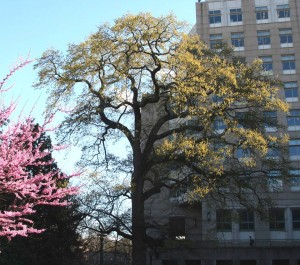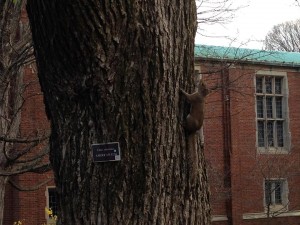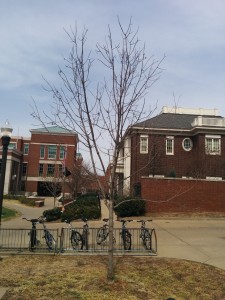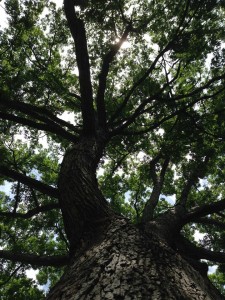Reflections on Vanderbilt’s trees from a recent graduate
In this guest blog post, Emma Steigerwald reflects on how the trees of the arboretum affected her decision to come to Vanderbilt and on how trees shaped her experience as a student.
When I was visiting college campuses as a high school senior, Vanderbilt stood apart for its trees. Other campuses were barren, or hosted insipid little ornamentals. Vanderbilt’s old, towering giants made it the only campus I visited to take advantage of its local ecosystem’s diverse beauty. Glowing in warm fire-tones in fall, and blossoming in delicate pastels in spring; to live at Vanderbilt is to live in an Appalachian microcosm.
I would be lying if I claimed that this campus character did not factor into my choice of undergraduate institution. Hiking, camping, and generally being out-of-doors was central to my family’s lifestyle throughout my childhood. With a university major in Molecular and Cellular Biology, I knew that I would be spending many, many hours studying in front of books and screens. I am convinced that Nature Deficit Disorder is a real phenomenon, and knew that on a campus like Vanderbilt’s this syndrome had no chance of distracting me from my studies. My favorite statistic to share with others when I told them that I’d decided to attend Vanderbilt was that its squirrel to human ratio is 3:1.
Vanderbilt is an urban campus, with all the benefits of an urban campus. Yet you’d never know you’re in the middle of Nashville, in this serene place of natural beauty. The honking cars and piercing pedestrian crossing signals sound persistently just beyond the campus fence. However, behind the thick screen of trees, the campus is a quiet place perfectly suited for study and for the generation of an independent student life.
I had no idea, entering Vanderbilt, the degree to which I’d get to experience nature on campus. I could never have imagined that, feeding the squirrels in McTyeire courtyard my second year, I’d get the opportunity to see a Broad-winged hawk swoop down and seize a squirrel right at my feet. I could never have guessed that, walking to an early-morning sociology course, I would get majorly sidetracked by the sight of an enormous Red-tailed hawk stripping meat off a squirrel on a low oak branch.
One of my favorite things about going back to campus, now that I’ve graduated, is the change that I see in the freshman quad. My first year at Vanderbilt in 2008, the newly-planted trees on this part of campus were no bigger than measly ornamentals. It was on old-campus, where all my classes were, that I had to get my daily tree fix. Already by my 2012 graduation, these trees have matured remarkably. It’s incredible to see the old photos of Vanderbilt from the 1870s, when so many of the giant, old-campus trees were newly-planted: I can just imagine, in some hundred years’ time, Vanderbilt students looking back at 2008 photos of the freshman quad, and feeling as awe-inspired as I do at the transformation from scawny saplings to monumental organisms.
 Emma Steigerwald is a 2012 Vanderbilt graduate with a B.S. in Molecular and Cellular Biology. She was a Cornelius Vanderbilt Honors Scholar under the Lanier Scholarship, Truman Scholar, and was named the Michael B. Keegan Traveling Fellow for 2013-14. She recently completed her project, which involved visiting major biodiversity hotspots around the world. She is now a doctoral student with a fellowship in biodiversity and conservation at the University of Freiburg in Germany.
Emma Steigerwald is a 2012 Vanderbilt graduate with a B.S. in Molecular and Cellular Biology. She was a Cornelius Vanderbilt Honors Scholar under the Lanier Scholarship, Truman Scholar, and was named the Michael B. Keegan Traveling Fellow for 2013-14. She recently completed her project, which involved visiting major biodiversity hotspots around the world. She is now a doctoral student with a fellowship in biodiversity and conservation at the University of Freiburg in Germany.



